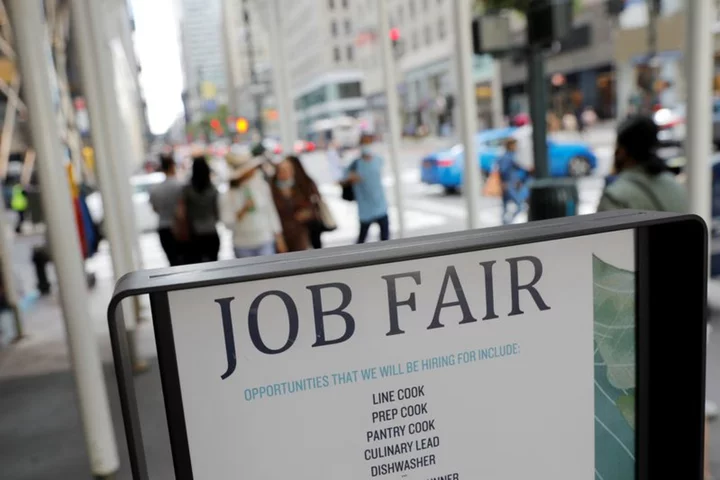By Lucia Mutikani
WASHINGTON The number of Americans filing new claims for unemployment benefits jumped to a 1-1/2-year high last week, pointing to cracks in the labor market as demand slows, potentially giving the Federal Reserve room to halt further interest rate increases next month.
With demand cooling, inflation pressures are subsiding. Producer prices rebounded modestly in April, leading to the smallest annual increase in wholesale inflation in more than two years, other data from the Labor Department showed on Thursday. The reports were seen as consistent with most economists' expectations of a recession by the end of the year.
"The Fed looks closer to winning the war on inflation today, but it risks losing the war on keeping the economy afloat and away from the shoals of recession," said Christopher Rupkey, chief economist at FWDBONDS in New York.
Initial claims for state unemployment benefits increased 22,000 to a seasonally adjusted 264,000 for the week ended May 6, the highest reading since October 2021. Economists polled by Reuters had forecast 245,000 claims for the latest week.
The four-week moving average of claims, considered a better measure of labor market trends as it strips out week-to-week volatility, rose 6,000 to 245,250, the highest level since November 2021.
Economists say claims in a 270,000-300,000 range would signal a deterioration in the labor market. Last week's surge could mark the start of an upward trend as the cumulative and lagged effects of the Fed's rate hikes broaden out in the economy. Layoffs, which were initially concentrated in the technology and housing sectors, appear to be spreading to other industries as companies gear for weak demand.
"While the claims series can always be volatile from week to week, there are no obvious distortions to today's number," said Michael Feroli, chief U.S. economist at JPMorgan in New York.
"Business labor demand has been gradually cooling and today's initial claims reading hints at potentially a more abrupt slowing."
Stocks on Wall Street were trading lower. The dollar gained versus a basket of currencies. U.S. Treasury prices rose.
LABOR MARKET STILL TIGHT
Unadjusted claims rose 13,969 to 234,084 last week. There was a jump in filings in Massachusetts as well as significant increases in California, Missouri, Texas and New York. They offset notable drops in Colorado, Georgia and Kentucky.
Still, the labor market remains tight, with 1.6 job openings for every unemployed person in March, well above the 1.0-1.2 range that is consistent with a jobs market that is not generating too much inflation. The Fed has raised its benchmark overnight interest rate by 500 basis points to the 5.00%-5.25% range since March 2022 and last week signaled it could pause its fastest monetary policy tightening campaign since the 1980s.
The number of people receiving benefits after an initial week of aid, a proxy for hiring, increased 12,000 to 1.813 million during the week ending April 29, the claims report showed. The so-called continuing claims remain low by historical standards as some of the laid-off workers are quickly finding employment.
In another report on Thursday, the Labor Department said the producer price index for final demand rebounded 0.2% in April after dropping 0.4% in March. In the 12 months through April, the PPI increased 2.3%. That was the smallest year-on-year rise since January 2021 and followed a 2.7% advance in March.
A 0.3% increase in the cost of services accounted for 80% of the rise in the monthly PPI. Services where boosted by a 4.1% advance in portfolio management fees.
There were also increases in the costs of food and alcohol wholesaling, outpatient care, loan services as well as hospital inpatient care, hotel and motel rooms. But the cost of long-distance motor carrying fell as did food retailing, airline tickets and securities brokerage, dealing and investment advice.
Portfolio management fees, airline fares and healthcare feed into the calculation of the Personal Consumption Expenditures (PCE) price indexes, the main inflation measures tracked by the Fed for monetary policy.
Services prices dipped 0.1% in March. Goods prices rose 0.2% in April after declining 1.0% in March. They were driven by an 8.4% surge in gasoline prices. Food prices fell 0.5%. Excluding the volatile food and energy components, core goods prices rose 0.2% after a similar gain in March.
The government reported on Wednesday that the annual increase in consumer prices slowed to below 5% in April for the first time in two years.
Excluding food, energy and trade services components, producer prices gained 0.2% in April after edging up 0.1% in March. In the 12 months through April, the core PPI rose 3.4% after increasing 3.7% in March.
But the moderation in annual consumer and producer inflation was unlikely to be replicated in the PCE price measures because of differences in methodology and weights.
With the CPI and PPI data in hand economists estimated that the core PCE price index rose by about 0.3%, matching March's gain. That would keep the year-on-year increase in the core PCE price index at 4.6%. For some, that meant the Fed would continue raising rates.
"Details imply stable PCE inflation at too-strong levels," said Veronica Clark, an economist at Citigroup in New York. "We continue to expect further hikes from the Fed in June and July."
(Reporting by Lucia Mutikani; Editing by Chizu Nomiyama and Andrea Ricci)

